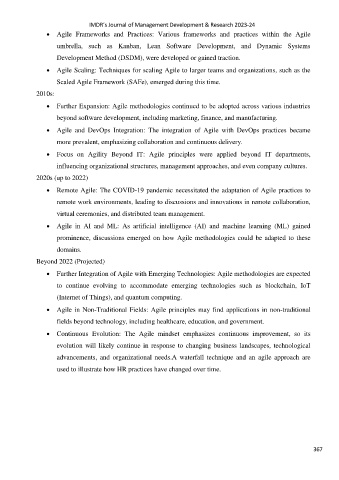Page 375 - IMDR JOURNAL 2023-24
P. 375
IMDR’s Journal of Management Development & Research 2023-24
Agile Frameworks and Practices: Various frameworks and practices within the Agile
umbrella, such as Kanban, Lean Software Development, and Dynamic Systems
Development Method (DSDM), were developed or gained traction.
Agile Scaling: Techniques for scaling Agile to larger teams and organizations, such as the
Scaled Agile Framework (SAFe), emerged during this time.
2010s:
Further Expansion: Agile methodologies continued to be adopted across various industries
beyond software development, including marketing, finance, and manufacturing.
Agile and DevOps Integration: The integration of Agile with DevOps practices became
more prevalent, emphasizing collaboration and continuous delivery.
Focus on Agility Beyond IT: Agile principles were applied beyond IT departments,
influencing organizational structures, management approaches, and even company cultures.
2020s (up to 2022)
Remote Agile: The COVID-19 pandemic necessitated the adaptation of Agile practices to
remote work environments, leading to discussions and innovations in remote collaboration,
virtual ceremonies, and distributed team management.
Agile in AI and ML: As artificial intelligence (AI) and machine learning (ML) gained
prominence, discussions emerged on how Agile methodologies could be adapted to these
domains.
Beyond 2022 (Projected)
Further Integration of Agile with Emerging Technologies: Agile methodologies are expected
to continue evolving to accommodate emerging technologies such as blockchain, IoT
(Internet of Things), and quantum computing.
Agile in Non-Traditional Fields: Agile principles may find applications in non-traditional
fields beyond technology, including healthcare, education, and government.
Continuous Evolution: The Agile mindset emphasizes continuous improvement, so its
evolution will likely continue in response to changing business landscapes, technological
advancements, and organizational needs.A waterfall technique and an agile approach are
used to illustrate how HR practices have changed over time.
367

